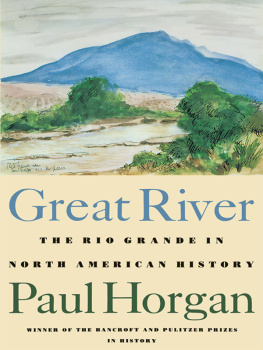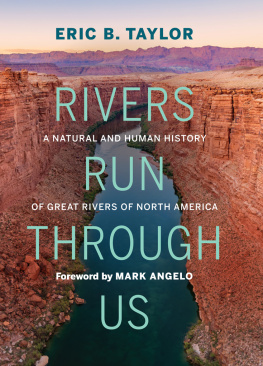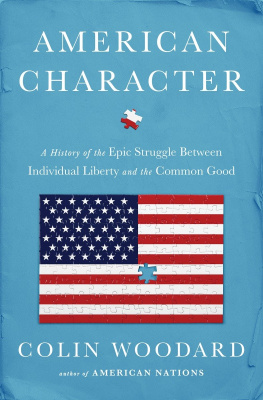Horgan - Great River The Rio Grande in North American History Vol 1 2
Here you can read online Horgan - Great River The Rio Grande in North American History Vol 1 2 full text of the book (entire story) in english for free. Download pdf and epub, get meaning, cover and reviews about this ebook. City: Middletown, year: 2012, publisher: Wesleyan University Press, genre: Art. Description of the work, (preface) as well as reviews are available. Best literature library LitArk.com created for fans of good reading and offers a wide selection of genres:
Romance novel
Science fiction
Adventure
Detective
Science
History
Home and family
Prose
Art
Politics
Computer
Non-fiction
Religion
Business
Children
Humor
Choose a favorite category and find really read worthwhile books. Enjoy immersion in the world of imagination, feel the emotions of the characters or learn something new for yourself, make an fascinating discovery.
Great River The Rio Grande in North American History Vol 1 2: summary, description and annotation
We offer to read an annotation, description, summary or preface (depends on what the author of the book "Great River The Rio Grande in North American History Vol 1 2" wrote himself). If you haven't found the necessary information about the book — write in the comments, we will try to find it.
Horgan: author's other books
Who wrote Great River The Rio Grande in North American History Vol 1 2? Find out the surname, the name of the author of the book and a list of all author's works by series.
Great River The Rio Grande in North American History Vol 1 2 — read online for free the complete book (whole text) full work
Below is the text of the book, divided by pages. System saving the place of the last page read, allows you to conveniently read the book "Great River The Rio Grande in North American History Vol 1 2" online for free, without having to search again every time where you left off. Put a bookmark, and you can go to the page where you finished reading at any time.
Font size:
Interval:
Bookmark:

Great River
by Paul Horgan
NOVELS
The Fault of Angels The Habit of Empire No Quarter Given The Common Heart Main Line West Give Me Possession A Lamp on the Plains Memories of the Future A Distant Trumpet Far from Cibola Whitewater
Mountain Standard Time
(containing Main Line West, Far from Cibola, and The Common Heart)
Mexico Bay
THE RICHARD TRILOGY
Things As They Are Everything to Live For The Thin Mountain Air
OTHER FICTION
The Return of the Weed The Saintmakers Christmas Eve Figures in a Landscape Humble Powers The Devil in the Desert
Toby and the Nighttime (juvenile)
One Red Rose for Christmas
The Peach Stone: Stories from Four Decades
HISTORY AND OTHER NON-FICTION
Men of Arms (juvenile) From the Royal City
New Mexicos Own Chronicle (with Maurice Garland Fulton)
Great River: The Rio Grande in North American History
The Centuries of Santa Fe Rome Eternal Citizen of New Salem
Conquistadors in North American History
Peter Hurd: A Portrait Sketch from Life Songs After Lincoln The Heroic Triad: Essays in the Social Energies ofThree Southwestern Cultures Maurice Baring Restored
Encounters with Stravinsky: A Personal Record Approaches to Writing
Lamy of Santa Fe: His Life and Times
Josiah Gregg and His Vision of the Early West
COLLECTIVE VOLUME
Of America East & West
Selections From the Writings of Paul Horgan
Great River
The Rio Grande in North American History
Paul Horgan
VOLUME ONE: Indians and Spain
VOLUME TWO: Mexico and the United States
WESLEYAN UNIVERSITY PRESS
Middletown, Connecticut
Published by Wesleyan University Press, Middletown, CT 06459
1984 by Paul Horgan
All rights reserved
Reprinted by permission of Farrar, Straus & Giroux, Inc.
Printed in the United States of America 10 9 8 7
CIP data appear at the end of the book
To Charles Arthur Henderson, 1907-1972, and to the students in my seminar on the American Southwest held at Wesleyan University
Preface to the Fourth Edition
i
In its length of nearly two thousand miles and its cultural evidence encompassing ten centuries and more, the Great River remains the unifying vein of history not only of the life adjacent to its banks, but also of the greater Southwest. There, if often far afield, the political, social, and geographical significance of the river can be traced through the times of five sovereigntiesthose of the Indian, Spain, Mexico, Texas, and the United States.
To do my subject anything like justice, I have hoped to produce a sense of historical experience rather than a bare record. This required me wherever possible to see events, societies, and movements through human character in action. While respecting the responsibilities of scholarship, I took every opportunity, when the factual record supported me, to stage a scene. Moreover, if here and there I halted the narrative of events to describe the various ways and customs of the people, then I had precedent for it, for Herodotus did the same, to our enrichment. Only when events are rooted in the soil of the culture might they seem to have a reality that endures.
ii
In manners of living, a long, slow sequence unfolded for the early river peoples. Prehistoric intuitions among them gradually gave way to knacks and simple ingenuitiesprimitive technologies to do with water, fire, agriculture, shelter, travel, weaponry. For centuries all these were developed without that sense of shock that accelerated rates of discovery produce. But with the waves of activity and means of control of the natural world that rose with the industrial revolution and the migratory imperatives of the nineteenth century, mans impact on the environment brought swift and radical change within a single human lifetime.
Into the Rio Grande country, ranging through the area of what became three immense modern states and touching the great length of the rivers immediate course, came railroads, electricity, exploitation of mineral resources, colonization, urbanization at key points, andnot to be undervaluedthe popular discovery of the natural aesthetic of generally benign climate over a landscape of most desirable beauty.
In modern days, therefore, population not only changed in character, it grew in a few generations to a size that threatened to create a dangerous imbalance between what was available to sustain life and what was demanded by headlong social increase. The problem was not exclusive to the Southwest, it plagued the nation and, indeed, with Latin America included, it invaded the hemisphere.
But it was in the Southwest that technological change became most rapidly visible. The desert country, having sustained sufficiently the modest requirements of the Indian, the Spaniard, and the Mexican, now had to meet the environmental levies of the United States genius for industry. Added to these were a foreshortened vision of the good life, which the American citizen and his suppliers made commonly necessary without much common foresight for the future effects of the technological society on such matters as pollution of air, earth, and water, andmost significant for the Southwestdangerous depletion of the very sources of water itself.
The Rio Grande, long an adequate though never a voluminous river except in flood tide, has been attended in modern times by concerned management in its government conservancy districts; but in many places the river has become only a trickle, and in others entirely dry, to be replenished only by flood from otherwise dry or meager local tributaries and by diminishing ground water, this always in the face of increasing needs of its resources in both the United States and Mexico.
iii
In the late twentieth century, the cultural history of the Rio Grande country turned toward the devices and applications of science for a redefinition of its modern character. None of these has had a stronger regional association than the fateful development of nuclear science.
Before the mid-century in several nations, searching experiments in the revolutionary process of creating nuclear fission worked to bring vast new powers of energy within mans grasp. It took fears and antagonisms and the stakes of war for the United States to apply atomic energy with all haste as a means of destruction on behalf of victory. The ultimate site for this development in weaponry was at Los Alamos, New Mexico, in rugged mesa country west of in central New Mexico, where the first test detonation of the bomb took place in August, 1945.
The welcome clarity of the sky brought another world-changing technic to a Rio Grande tributary, the Pecos River, when Robert Hutchings Goddard chose Roswell, New Mexico, in the Pecos Valley for the continuation, and the eventual fruition, of his experiments in liquid fuel rocketry, which directly led to the achievement of space travel.
Added to these technical disciplines, with their ultimate administrative sprawl, was the wide use of southwestern lands for training the armed forces in World War II.
Through all such energies the Southwest, the Rio Grande ambience, was discovered by the nation at large, and the characters of its traditional life, with all the vestiges of its previous centuries still holding to the commingled styles of three races, was changed more swiftly and radically than ever before. The chronicle of life in the region always could be told in terms of change, whether at the pace measured by geology, archaeology, exploration, or successive national conquests; but the changes wrought by machine technics over life in the southwest desert empire have come so fast that designs for its future integrity seem almost to be overtaken before they can be effected.
Next pageFont size:
Interval:
Bookmark:
Similar books «Great River The Rio Grande in North American History Vol 1 2»
Look at similar books to Great River The Rio Grande in North American History Vol 1 2. We have selected literature similar in name and meaning in the hope of providing readers with more options to find new, interesting, not yet read works.
Discussion, reviews of the book Great River The Rio Grande in North American History Vol 1 2 and just readers' own opinions. Leave your comments, write what you think about the work, its meaning or the main characters. Specify what exactly you liked and what you didn't like, and why you think so.







